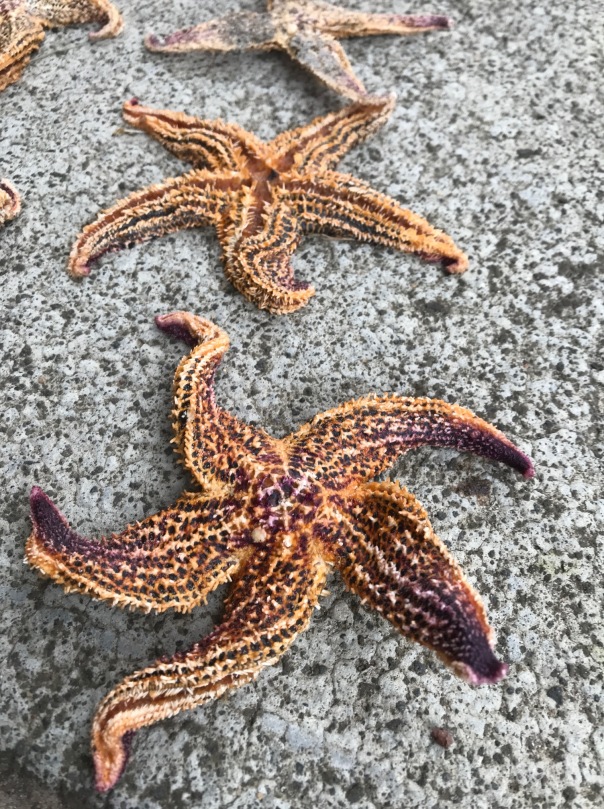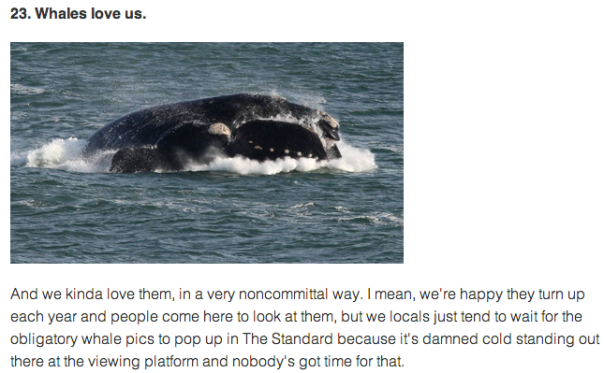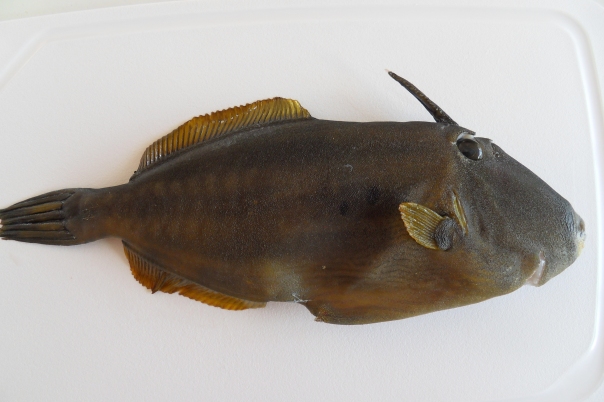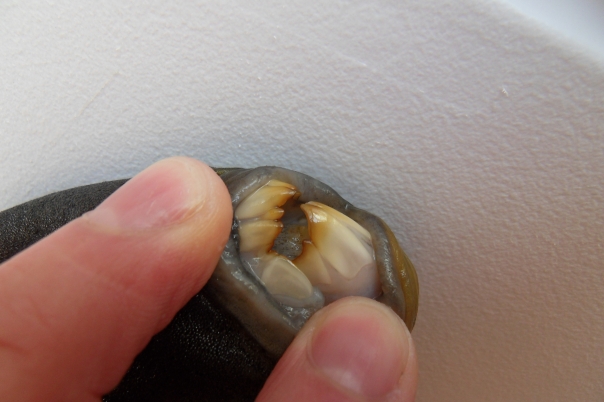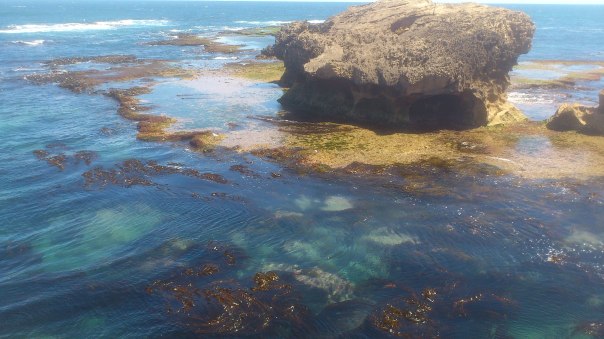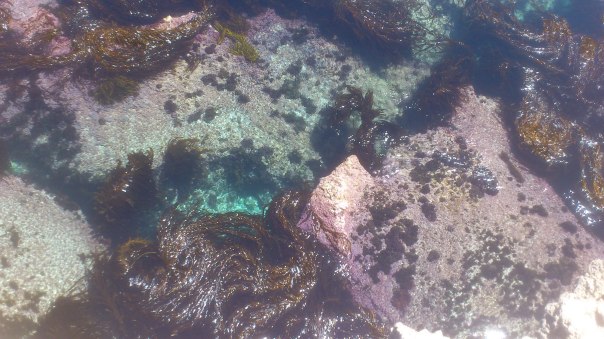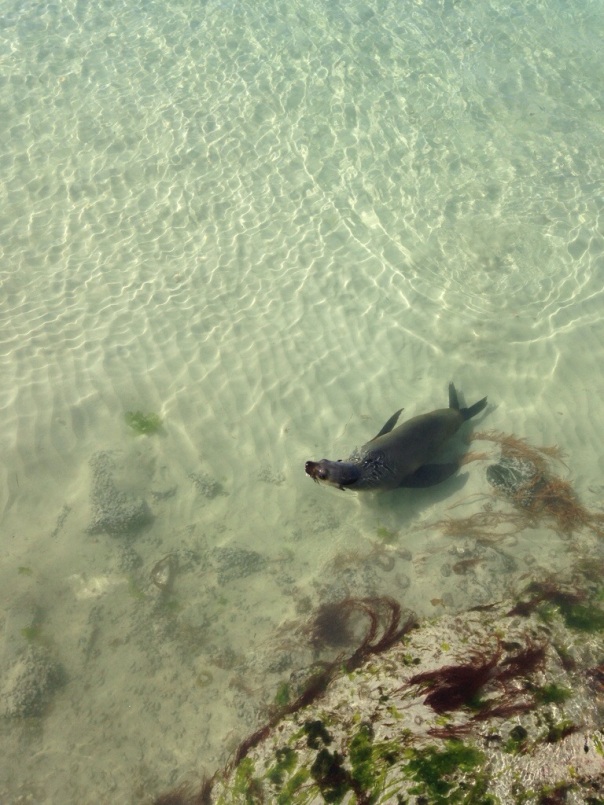 Spotted this seal and his mates a few months ago hanging around the marine sanctuary. It wasn’t long before one of them worked out that begging for fish in front of the pier is an easier way to get snapper carcasses and other tasty leftovers!
Spotted this seal and his mates a few months ago hanging around the marine sanctuary. It wasn’t long before one of them worked out that begging for fish in front of the pier is an easier way to get snapper carcasses and other tasty leftovers!
Seals in this area don’t have too much to worry about: the larger colony at Lady Julia Percy Island has to contend with a variety of sharks including makos and threshers and the occasional opportunistic orca.
Category Archives: Victoria
Stopping the spread of marine pests in Victorian waters
While out on a seagrass monitoring boat trip with Parks Victoria on the Pelican1 recently, I caught up with acting Marine Science Program Manager Mark Rodrigue.
Mark talked about the new campaign Check Clean Dry that’s aimed at stopping the spread of marine pests such as North Pacific Seastars (Asterias amurensis), wakame (Undaria pinnatifida), Pacific Oyster (Crassostrea gigas) and some tidal and benthic habitat critters.
The seastars are the most concerning of all, popping up in previously undocumented areas in large numbers around Port Phillip Bay and Westernport near Melbourne, and across into South and East Gippsland at Wilsons Prom and Gippsland Lakes. Here’s a few I removed on a recent dive near my home at Frankston, a spot called Olivers Hill where I’ve previously never seen these seastars in any significant numbers. Recent sea surface temperature warming, a decline in their predators (the eleven armed seastar) or other factors may be at work here.
Mark spoke to Ross and John on local radio station 3AW this morning after some recent sightings of seastars near the mouth of the Maribyrnong River:
Cartoon series depicts the personalities of Port Phillip Bay
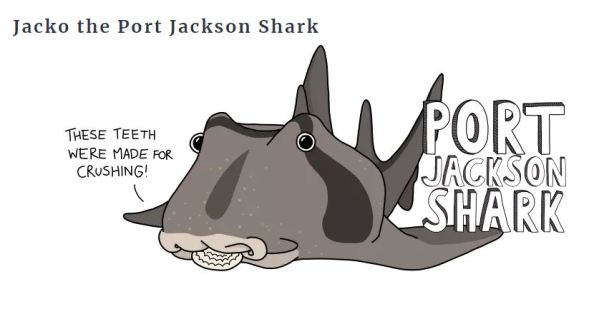
Old mate Jacko is part of a cartoon series created by Amellia Formby from the Wing Threads project for the Connected to Port Phillip initiative, which aims to tell the stories of the cultural heritage and amazing wildlife in and around Melbourne’s Port Phillip Bay.
Schools of Port Jackson sharks can often be found in marine protected areas in the bay such as Rickett’s Point, and in many protected rocky reef systems inside the bay and around the open beaches of the Mornington Peninsula. Safe to say, if you’ve never seen Jacko or his friends, then you need to get out diving more often!
Amellia will be demonstrating her great artworks at Day by the Bay Point Cook on Saturday March 23.
Back to the old country – more beaches, sunrises and penguin islands
Heading back to Warrnambool for a work trip this week and taking a few days off to make it a long weekend. After three years away from this place it’s still tough to go back and see the kind of places we used to enjoy regularly – the breakwater, Middle Island (home of the penguin colony featured in the Oddball movie) and the beaches less than 10 minutes from town but so often seemingly isolated from the rest of the world. These beaches also used to be hotspots for four-wheel-driving but better enforcement and protection of bird nesting sites has meant that wheel tracks are thankfully harder to find.
Weekend Wanderings: Sunset along the river — LEANNE COLE Fine Art Photographer
A couple of days ago I was loaned the new Nikon camera, the D500, from Nikon Australia. It is Nikons new…
via Weekend Wanderings: Sunset along the river — LEANNE COLE Fine Art Photographer
As a resident of the often-maligned state of Victoria since 2001 (apart from two years in the UK), I’ve spent enough time in Melbourne city to have seen postcard-worthy sunsets over the river on a regular basis. Though I’m not a real city lover, the past four months have been spent working in a 30-storey building that has great views of the MCG, Melbourne Tennis Centre, Yarra River and Port Phillip Bay. And not being able to get out in the water as much as I’d like is tempered somewhat by looking out at the bay or river and soaking up those amazing views.
New shellfish reefs to be planted in Victorian bay
Dredging and bottom trawling of Port Phillip Bay in Victoria have destroyed most of the natural shellfish reefs in the 230 years since European settlement of Australia.
This new plan reported in the Age newspaper last week will help to restore shellfish reefs in the bay with the aim of increasing habitat for flathead, snapper and other commercially and recreationally valuable fish.
Shellfish reefs will be re-created on the bottom of Port Phillip Bay in a historic project that aims to improve marine habitats in Victoria’s largest bay.
Researchers say that if the reefs can be successfully established as expected, they would provide healthy habitats for shellfish like mussels and oysters. They would also provide habitat, shelter and food options for fish such as snapper, flathead, rockling and many other fish that live in the bay. They would also help improve water quality.
Shells from mussels, scallops and oysters that have been discarded by the seafood industry and restaurants could be sought as part of the project. They would eventually be placed in the bay at one of three locations, in order to form a base for the early stage of the shellfish reefs. Some artificial material could also be used.
But the project requires more than old shells. Millions of baby oysters and mussels, which will be bred at the Victorian Shellfish Hatchery at Queenscliff, will be used to colonise the reefs in the $270,000 pilot project. The baby oysters and mussels will attach themselves to shells at the hatchery, before they are placed in the water on top of the old shells.
The project, to commence this year, is expected to be formally announced on Saturday by Agriculture Minister Peter Walsh, the minister responsible for fisheries. It will be funded jointly, with $120,000 from the state’s Recreational Fishing Initiative, and $150,000 from The Nature Conservancy, an international organisation that undertakes conservation works around the world.
A patchwork of reefs will be restored at three locations, near Geelong, Chelsea and St Kilda, in about eight to 12 metres of water.
Local marine sanctuary loved and ignored in equal measure
This is a great recent video from the Friends of the Merri Marine Sanctuary, a small and dedicated group helping – as one goal – to remind local people about the amazing natural features and marine life on their doorstep.
At a lecture and networking day on the weekend hosted by Deakin University and the Victorian National Parks Association, a member of the Friends group mentioned how hard it can be to get the support and interest of people outside the conservation community. I could see similar parallels with another spectacular occurrence that Warrnambool people often ignore.
Living near one of the calving grounds for southern right and humpback whales, people in this area can tend to be ambivalent about the excitement generated in the tourism industry each time the whale watching season approaches.
A recent humorous list of 30 things only a local would understand had this gem at number 23:
Funny (maybe just as a Warrnambool local) but it highlights that disinterest I spoke of – we’re happy the whales are here but we’re just as happy to ignore them because it doesn’t suit us to stand around for hours (and it can be hours between ‘showings’). Same goes for conservation – local people are generally happy that someone is doing it but not bothered to get involved themselves.
What can you do with apathy like that? It was an open question to the weekend’s session and though there were some good suggestions, as usual it was hard to come up with the perfect answer. My idea was to keep the good work these people do at the forefront, tell the media, tell politicians, help to get relevant policy change at the state and federal level and let your own passion inspire other people. Al Gore was one who helped ‘cure’ apathy over climate change on a global level but it’s even more important to make small communities like ours care about the natural wonders they take for granted.
Seal pup all grown up!
It’s leatherjacket season! Also, this is not a fashion article…
Leatherjackets are amazing fish, in such colourful varieties. In the past two months, I’ve spotted five different species from the Horseshoe to the Yellowfin species (Meuschenia trachylepis) pictured. This species is often seen with the Six-spined leatherjacket, which I mistook this fish for in my original post on Facebook.
Some people have the idea that marine biologists shouldn’t be out fishing for the species we are studying but it can be a great way of identifying fish, learning where they are and aren’t present and the warning signs when stocks start dwindling.
Spearfishing is now one of my favourites sports – it’s low-impact on the marine environment as opposed to other fishing forms, as we target specific fish and only go for the type and size we want.
Obviously some people still abuse catch and size limits as in any form but the crew I dive with all play by the rules (we’re all marine biology undergrads and my partner also works for the government department dealing with fisheries compliance…)
This species has some serious teeth, used for crushing molluscs and slow-moving sessile animals. Anecdotally, leatherjackets aren’t fast-moving like the local zebrafish or bluethroat wrasse – most of the leatherys I’ve seen tend to hide under ledges or in crevices rather than try to outswim their prey.
Perfect weather for lobster and abalone fishing – another reason I love south-west Victoria
Over the Christmas/New Years break, crowds of Melbourne, interstate and overseas visitors have been flocking to the small towns along the Great Ocean Road to get some (hopefully) sun, sand and surf and relaxation time. While the sun hasn’t been playing fair that much and surfers will have been disappointed, snorkeling and scuba dive conditions have been very good.
The beauty of this south-western stretch of coast is that, for every beach teeming with day-trippers, there’s always another hidden, empty spot nearby. Sometimes they are less accessible, such as this perfect dive spot close to Warrnambool (and less than 200m away from the remains of the dead whale stranded on the rocks in July), but often they are just further away from the usual tourist traps such as the 12 Apostles, Bay of Martyrs and London Bridge.
If you’re after blacklip (or less commonly, the tastier greenlip) abalone or southern rock lobster, these out-of-the-way spots are well worth checking out. A dive spot just over 400m from a tourist campervan-filled carpark near Port Campbell yielded a feast of abalone on Thursday and scuba divers reported that some of the deeper ledges held some sizeable crays.
Victoria is one of the biggest wild abalone breeding grounds in the Southern Hemisphere and the strict regulations (and heavy fines for breaking the rules) on recreational collecting have helped to maintain healthy stocks in many less-populated areas.
I won’t give away any of the better local spots but if you’re after a fresh local feed, checking out some of the dirt tracks near the coast can bring great rewards.
